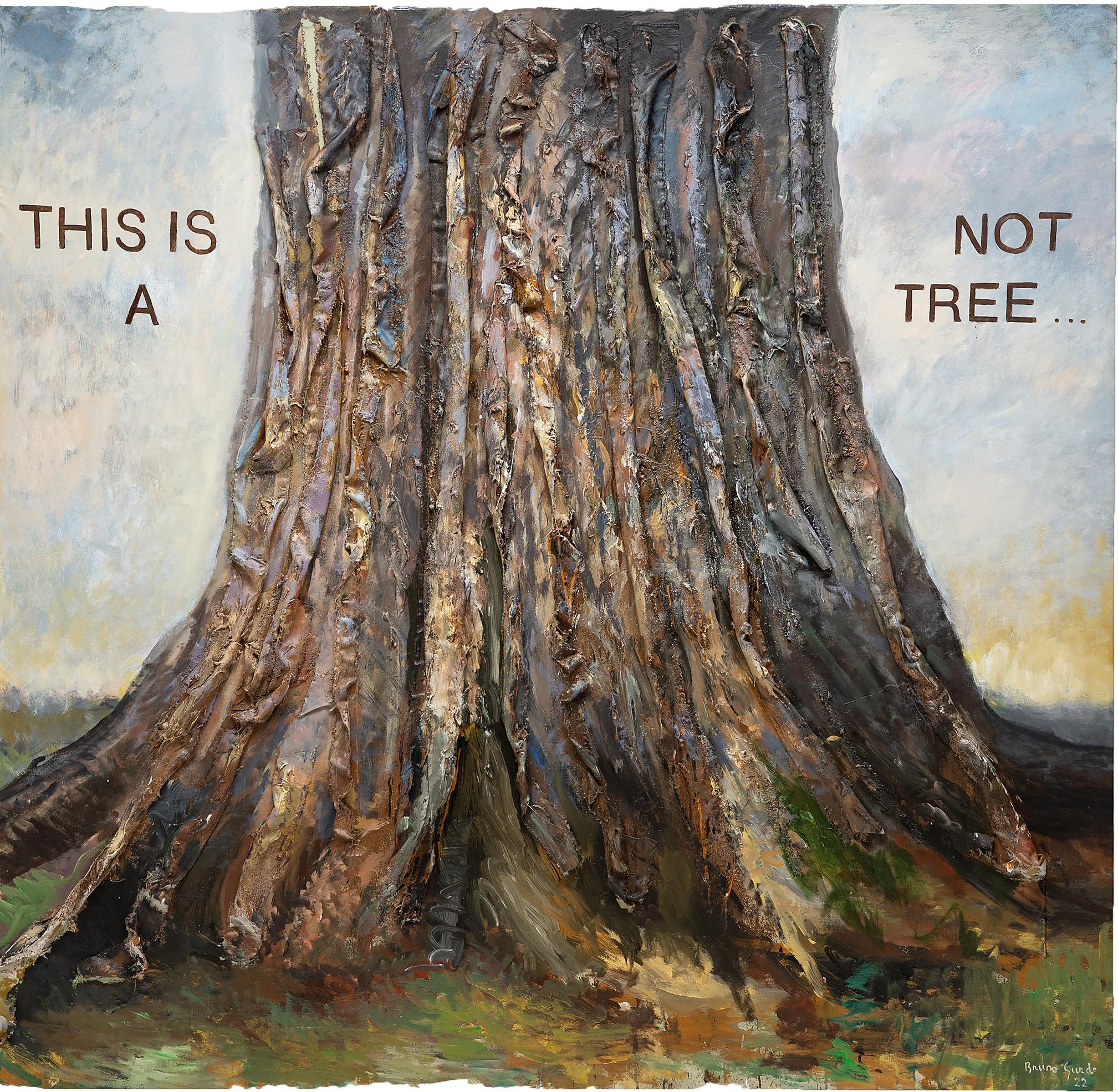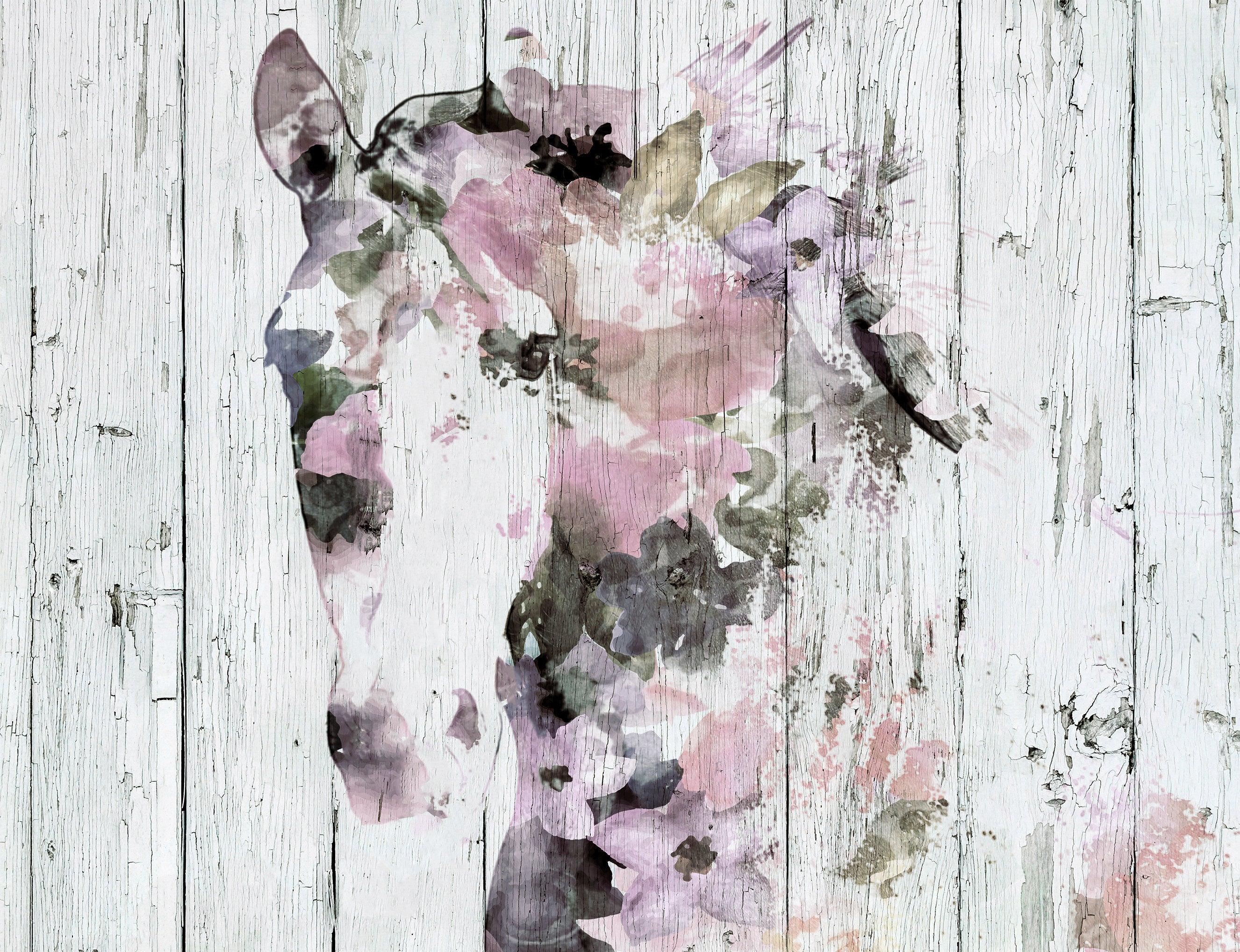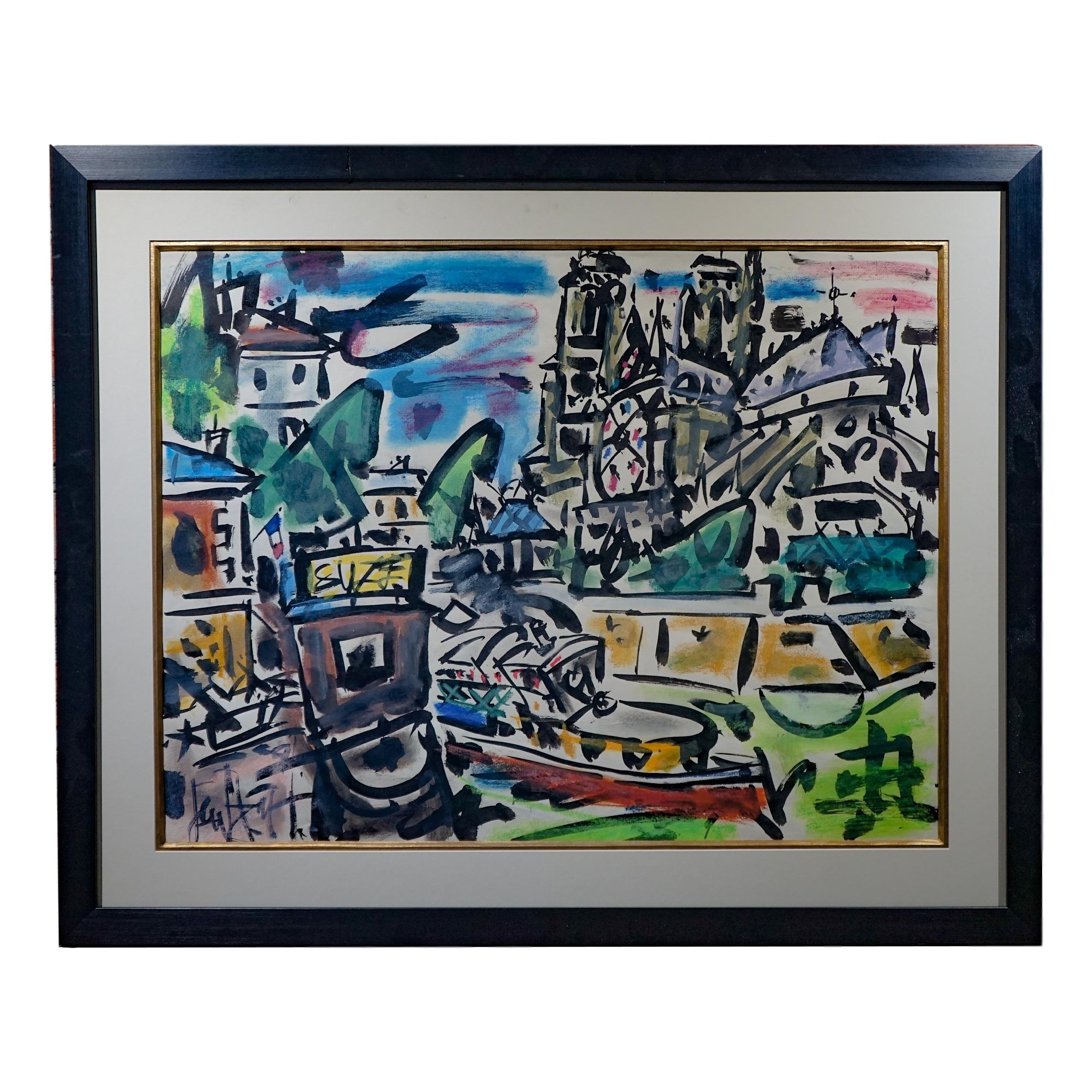Items Similar to A Stroll Through the Village, Two Figures
Video Loading
Want more images or videos?
Request additional images or videos from the seller
1 of 5
Théo TobiasseA Stroll Through the Village, Two Figures
About the Item
A Stroll Through the Village, Two Figures
By. Theo Tobiasse (Israeli, French, 1927-2012)
Signed Lower Left
Unframed: 40" x 27.5"
Framed: 55.5" x 42.25"
Théo Tobiasse came from a Lithuanian-Jewish immigrant family who moved to Paris in 1931 for economic reasons. Here Tobiasse completed an apprenticeship at the École des Arts Décoratifs, which was interrupted by the outbreak of World War II. The family lived hidden in the French metropolis for over two years without ever leaving the small apartment or even lighting it up. The time was spent reading, drawing and playing chess, and Tobiasse built up a huge pool of drawings from which he could later draw.
After the end of the war, he worked as a graphic designer for the Hermès company in Paris and Nice for 15 years. He also painted, mostly at night. After his first successful exhibition appearance in Nice, he decided to pursue a career as a freelance artist. His work, which was inspired by the Nouvelle École de Paris, quickly found international recognition and won awards such as the Dorothy Gould Prize in 1961.
In 1976 he moved his studio to Saint-Paul-de-Vence, and from 1980 he traveled regularly to New York, where he stayed for several months each year. He was close to his friends and supporters, the art dealers Kenneth and Sherri Nahan. The paintings and prints by Théo Tobiasse, comparable to those by Marc Chagall, often contain themes from Jewish culture, contain allusions to biblical content and deal with erotic fantasies as well as themes of loneliness and isolation. The artist contrasted the often difficult subject matter of his works with a dance-like, flowing language of forms and bright colors.
- Creator:Théo Tobiasse (1927 - 2012, French, Israeli)
- Dimensions:Height: 40 in (101.6 cm)Width: 27.5 in (69.85 cm)
- Medium:
- Movement & Style:
- Period:
- Condition:
- Gallery Location:Missouri, MO
- Reference Number:1stDibs: LU747311880152
About the Seller
5.0
Vetted Seller
These experienced sellers undergo a comprehensive evaluation by our team of in-house experts.
Established in 1970
1stDibs seller since 2017
141 sales on 1stDibs
Typical response time: 21 hours
- ShippingRetrieving quote...Ships From: Missouri, MO
- Return PolicyA return for this item may be initiated within 2 days of delivery.
More From This SellerView All
- NudesLocated in Missouri, MONudes By. Salcia Bahnc (Polish, American, 1898-1976) Signed Lower Middle Unframed: 14 x 18 inches Framed: 23 x 26 inches Painter, illustrator, printmaker, teacher. Born in Dukla, Poland. Though she was born in Dukla, a town in south-eastern Poland, she moved to Prsemysl, one of the largest and most ancient cities of southern Poland, at a young age. Her mother was reportedly descended from the "Van Ast" family, a Dutch dynasty that produced several artists, including Balthasar van der Ast (1593/4 - 1657). According to one art historian she came to New York at the age of five (c. 1903), and another, at the age of eight (c. 1906). Her family was Jewish and reportedly quite wealthy. Why they would have left imperial Austria, under whose sovereignty either of her proposed birth cities were under, is unknown. However, while these areas did not suffer the pogroms typical in neighboring imperial Russia, the Austro-Hungarian empire had become much more anti-Semetic, which may have hasten there departure. How, according to one source, they ended up living in the Jewish ghetto of New York is extremely puzzling. Did they loose their wealth to some business disaster? Where they forced to leave it behind? Was there some familial tragedy? We may never know. In her youth she lived first in New York City and then in Boston, Massachusetts, where her family had relatives. It is reported that when she was in fourth grade she was found to be so competent in drawing that for the next two years she taught a drawing class after school for the other children. In Boston, Bahnc's mother eventually remarried and moved the family to Chicago where the young artist was primarily raised. In Chicago she worked during the days as a sales clerk in a department store. At night she put herself through school at the School of the Art Institute of Chicago (SAIC) and taught at her former alma mater after her graduation during the years 1923-1929. She also studied at the Chicago Academy of Fine Art. She took up design work and began exhibiting painted silk creations at a private Chicago gallery (probably Thurber, see below). The first museum exhibitions she is known to have participated in were held at the Art Institute of Chicago. During this period she became known for her portraits. Originally a resident alien, she was naturalized at the district court of Chicago, Illinois in July of 1913. In 1920 she lived on East Ontario Street in Chicago in a neighborhood filled with art studios and artists, including James Allen Saint-John (1872-1957), Paul Bartlett (1881-1965), Pauline Palmer (1867-1938), and George Ames Aldrich (1872-1941). It is in Chicago that she saw her greatest success as an artist. In 1927, Chicago art dealer Chester H. Johnson said of her work: "The Art of Salcia Bahnc is a sincere manifestation of the spirit we know as 'Modernism' . . . . . . She is the spirit of the Age, not its Fashion." Local reviewers agreed, one going as far to say that her exhibition was " . . . the most interesting one man show by a young artist that has ever been presented to Chicago, and I keep telling myself that New York will get her if we don't watch out." She was apparently a favorite and friend of art critic Clarence Joseph Bulliet (1883-1952), who authored a number of books and articles that praised Bahnc's work. Bulliet was central in introducing and popularizing modern art in the mid-western United States. In his book Apples and Madonnas: Emotional Expression in Modern Art (1935) he called Bahnc a "A thorough Expressionist." A year later in his book The Significant Moderns and Their Pictures (1936) he noted that one of her paintings of a nude was ". . . powerful in its elemental brutality." During this period other critics reported positively on the work she was producing. Ida Ethelwyn Wing reported in a volume of the Delphian Text (1930) that Bahnc, was without doubt, ". . . the most vigorous and intensively original of the American Expressionists." Paul Masserman and Maxwell Baker said of her in their work The Jews come to America (1932) that she was part of a group of artists that were "Chief among modern Jewish painters. . . " Salcia Bahnc traveled back and forth to Europe during the late 1920s and into the 1930s, a period when she faced the rise of totalitarianism. She wrote about this fact to a fellow artist to whom she commented " . . . about the difficult art scene in Paris . . . . . . and the growing power of fascism." In 1930 she was maintaining a studio in New York City at 1218 East 53rd Street and a residence in Brooklyn, Long Island. She returned to France where she married a French citizen and writer named Eugene Petit (b. 1901) and bore a son there named Alain Petit (b. 1934). She again returned to the United States in November of 1937 and traveled back to France after a brief stay in America. During her stay she continued to exhibit in Chicago, where Quest Galleries gave her a solo show. Like so many ex-patriot authors and artists who were living in Paris, she found herself trapped in France (first in Paris, then in Mayenne) following the German invasion in 1940. Being of Jewish extraction the situation could prove to be quite dangerous if she were reported or discovered by German authorities. She and her husband were able to obtain passports and escape to Portugal where in August of 1941 they boarded the S. S. Escambion to return to America. In 1940, American Export Lines, owners of the Escambion, discontinued its normal Mediterranean routes and placed their ships into service sailing from Lisbon, Portugal to New York City. Over the next two years (1940 - 1941) their ships played an important role in transporting thousands of people who were trying to escape the Nazi regime before America's own entry into World War II. One survivor, Ludwig Lowenberg, who sailed on the Escambion on the same day that Bahnc did, reported the ordeal his family endured getting to Lisbon to his own descendants: "[The family] received their American visa on May 28, 1941, only three days before the U.S. consulate in Stuttgart closed for the duration of World War II. They left Berlin on June 23, 1941, traveling for 27 hours on a locked train to Paris. There they were forced to spend an additional night in the locked train until their coach was attached to a train headed for San Sebastian in Spain. After an overnight hotel stay in San Sebastian, the train (now no longer locked) continued to Lisbon. All in all it took six days from Berlin to Lisbon. They remained for four weeks in Lisbon until they embarked on the Excambion for New York." Bahnc had given up her citizenship during her time in France and was forced to reapply for naturalization once again upon her return. She was living in New York City at 101 West 85th Street when she was re-naturalized in April of 1947. Exactly how much of her artwork was lost in Europe is not known. Clearly, she would not have been able to bring much, if anything, with her during her escape. One writer had noted that between 1930 and 1934 she had worked hard to prepare a large group of new works for a show in Paris. Between those, and what she would have produced during the next six years, the actual amount of the loss might have been staggering. Bahnc's 1942 exhibition with Julio de Diego included works recalling the suffering going on in Europe. One work in the exhibition was a portrait of the painter Katherine Dudley, who, at the time, was reportedly interned near Paris. In the later years of her career she worked extensively as a teacher and illustrator of children's books. In 1950 she taught at the Evanston Art Center, where she lead a demonstration in portrait painting. She authored or illustrated a number of works during and after World War II, including: The House in the Tree and Other Stories of Places, People and Things (1941); Claude Of France: The Story Of Debussy For Young People (1948); Time for Poetry (1951); Hidden Silver (1952); From Many Lands - The Children's Hour, Volume 9 (1969); and That Boy (no date). She returned to teach at the School of the Art Institute of Chicago during 1943-44 and 1947-53; and taught later at the Garrison Forest School in Garrison, Maryland, from 1955-57. Bahnc was known to have exhibited widely, both in Europe and in America. Her known lifetime exhibitions include: The Art Institute of Chicago, Chicago, IL, 1919-29, 1942 (The 53rd Annual; and Room of Chicago Art: Exhibition of Paintings by Salcia Bahnc and Julio de Diego), 1943; Chicago Architectural...Category
20th Century Expressionist Nude Paintings
MaterialsCanvas, Oil
- Max Beckmann Retrospective (The Saint Louis Art Museum Sept 7-Nov. 4, 1984)By (after) Max BeckmannLocated in Missouri, MOThis is a vintage museum exhibition poster from the Max Beckmann Retrospective at the Saint Louis Art Museum, 1984. Max Beckmann was...Category
1980s Expressionist Figurative Prints
MaterialsOffset
- Portrait of VictoryBy Paul PletkaLocated in Missouri, MO"Portrait of Victory" By Paul Pletka (1946- ) Image Size: 30" x 23" Framed: 42" x 36" Signed: Lower Right Paul Pletka is a neo-surrealistic painter inspired by his fascination from early childhood with Native Americans of the Southwest. His style, described as neo-surrealistic, "is both realistic and deeply spiritual, being highly sensitive to the inner thoughts of Native Americans." Paul Pletka was born in southern California in 1946 and currently resides in New Mexico. After high school, he won a scholarship to Arizona State University and then transferred to Colorado State University, but feeling disappointed in his college art training, did not paint seriously until the late 1960s. His works of art have been exhibited in one-man shows in Colorado, New Mexico, Arizona, Texas, Illinois, New York, Kansas and Missouri continuously since 1964. Pletka's paintings are in more than 40 private and public art collections including the Albany Museum of Art, Albany, GA; Hallmark Cards, Kansas City, MO; Mel Pfaelzer Collection, University of Northern Illinois, De Kalb; the Norton Gallery & School of Art, West Palm Beach...Category
20th Century American Modern Mixed Media
MaterialsPaper, Mixed Media
- AlphonsineBy Robert KushnerLocated in Missouri, MORobert Kushner (American, b. 1949) Alphonsine, 1983 30 x 22 inches without frame 32.75 x 25 inches with frame Titled Lower Left Signed and dated Mid Lower Right A member of the Patt...Category
1980s American Modern Mixed Media
MaterialsPaper, Mixed Media, Acrylic
- Cone Drawing with SculptureLocated in Missouri, MOCone Drawing with Sculpture By Jane Sauer (b. 1937- ) Cone Drawing Unframed: 30" x 31.5" Cone Drawing Framed: 37" x 29" Cone Sculpture: 27" x 4" Born i...Category
20th Century Modern Mixed Media
MaterialsLinen, Paper, Mixed Media, Wax
- Webster's Birthday CakeBy Larry RiversLocated in Missouri, MOCast Paper with Hand-Coloring 19 x 19 inches Signed and Numbered 4/15 *In Plexiglass Shadowbox Frame (27.5 x 27.5 inches) Figurative* artist Larry Rivers was born in the Bronx in 19...Category
1980s Pop Art Mixed Media
MaterialsMixed Media
You May Also Like
- BreakfastLocated in Wareham, GBBreakfast 2016 by Juliane Hundertmark is from the artists 'Breakfast' exhibition at Knight Webb Gallery Brixton in 2017. The painting was purchased...Category
2010s Expressionist Figurative Paintings
MaterialsCanvas, Mixed Media, Oil
- "This is Not a Tree, " Mixed Media on Canvas, 2022By Bruno SurdoLocated in Chicago, ILChicago-based fine art painter Bruno A. Surdo is classically trained in drawing and oil painting in the tradition of Renaissance masters. With strong command of the human form, Surdo...Category
21st Century and Contemporary Expressionist Mixed Media
MaterialsMixed Media, Acrylic
- Woman expressionist portrait mixed media paintingBy Modest Cuixart i TàpiesLocated in Barcelona, BarcelonaFrame size 79x64 cm.Category
1980s Expressionist Mixed Media
MaterialsMixed Media
- Horse Farmhouse Pink Purple White Mixed Media Painting on Canvas 48 x 36"By Irena OrlovLocated in Sherman Oaks, CAFarmhouse Horse Painting 48 x 36” inches, Mixed Media: Digital, Watercolor, Acrylic, Stucco, Crackle Paste, Gel Medium One-of-a-kind 2019 in Los Angeles SPECIFICATIONS: - Fine art c...Category
2010s Expressionist Mixed Media
MaterialsCanvas, Acrylic, Digital, Mixed Media
- Refreshing Gelato Grid, Vivid Tones Modern Painting, Diptych, Cabin Beach, 2021Located in Barcelona, ES"Refreshing Gelato Grid" is an abstract painting by Spanish artist Natalia Roman. It is a beautiful series of rhythmic brushstrokes combined with subtle tones and unique shapes that is both classy and fresh. The use of vivid colors on a white background reminds the beautiful vintage beach cabins...Category
2010s Expressionist Abstract Paintings
MaterialsArchival Ink, Mixed Media, Oil, Acrylic, Watercolor, Archival Paper
- Expressionist Notre Dame of Paris with the Seine River and TugboatBy Gen PaulLocated in New York, NYGen Paul (1895-1975), an important French Expressionist painter, worked and Lived in Montmartre. Painting Depicts a mixed media gouache view of No...Category
1940s Expressionist Mixed Media
MaterialsMixed Media




